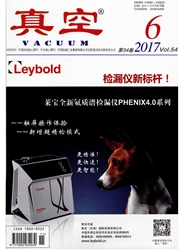

 中文摘要:
中文摘要:
高功率脉冲磁控溅射具有高的金属离化率,在薄膜制备表现出巨大的优势,成为当前磁控溅射技术领域一个新的发展趋势。高功率脉冲磁控溅射的放电特性、等离子体特性等微观参数对薄膜质量控制具有决定性作用,分析宏观参数如何影响微观参数,有利于提高薄膜质量,稳定工艺。因此,本文研究了脉冲与直流电源并联模式的复合高功率脉冲磁控溅射过程中,脉冲电压(400~800 V)对Ti、Cr靶在Ar气氛中的放电特性、等离子体参数(等离子体电势、电子温度、电子密度)、基体电流的影响。结果表明:复合高功率脉冲磁控溅射Ti、Cr靶放电过程中,脉冲电压的增加有利于脉冲作用期间的靶电压、靶电流、基体电流增加;当Ti靶脉冲电压为600 V或Cr靶脉冲电压为700 V时,电子密度出现较大值。Cr靶与Ti靶放电相比,前者的靶电流、基体电流、等离子体电势、电子温度比后者更高,而电子密度却更低。
 英文摘要:
英文摘要:
High power impulse magnetron sputtering(HIPIMS) has a higher ionization rate of sputtered atoms. It is beneficial to the thin films growth with improved adhesion, microstructure and uniform deposition onto complex-shaped substrates. Hybrid HIPIMS is a new-generation of HIPIMS technique with a pulse and direct current power supply paralleled connection operation. The influence of pulse voltage(400-800 V ) was investigated on important factors of Ti, Cr discharge and plasma parameters(plasma potential, elec- tron temperature and electron density) in Ar atmosphere. The results show that, with the increasing of pulse voltage, the absolute value of target voltage, target current, substrate current and electron density increases while the plasma potential and electron tem- perature decrease. However, the plasma potential, electron temperature increases and the electron density decreases after about 600 V, 700 V for Ti, Cr, respectively. We found that the target current, substrate current, plasma potential and electron temperature of Cr are lower than Ti at the same conditions whereas the electron density is higher, which indicates the number of charged ions on Ti discharge is higher.
 同期刊论文项目
同期刊论文项目
 同项目期刊论文
同项目期刊论文
 期刊信息
期刊信息
